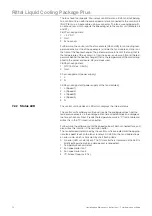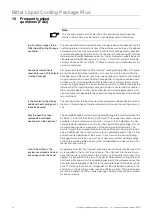
85
Operating and Maintenance Instructions – 11 Glossary
Rittal Liquid Cooling Package Plus
11
Glossary
1 U server:
1 U servers are very flat and deep, modern high performance servers, whose
height corresponds to one height unit (1 U = 44.54 mm, the smallest standard
height division). Typical dimensions are (W x D x H) 19" (482.6 mm) x 800 mm
x 1 U.
These systems normally include 2 CPUs, many GB RAM and hard drives, so
that they require up to 100 m
3
/h cooling air at a maximum of 32°C.
482.6 mm (19") level:
The front sides of the devices built into the server enclosure form the 19"
(482.6 mm) level.
Blade server:
By orienting dual CPU systems vertically and placing up to 14 units on a com-
mon backplane to provide for signal routing and power supply, one has a so-
called blade server.
Blade servers can "generate" up to 4.5 kW heat loss per 7 U and 700 mm depth.
"Front to back" cooling
principle:
The devices built into the server enclosure are normally cooled according to the
"front to back" cooling principle.
Under this cooling principle, cold air supplied by external air conditioning is
blown to the front of the server enclosure. The fans in the devices built into the
server enclosure direct this air horizontally through the server enclosure. The
air is warmed through this process and is exhausted out the rear side of the en-
closure.
Fig. 70:
"Front to back" cooling principle as an example in a 1 U server
Hotspot:
A hotspot is the concentration of thermal energy in a small area.
Hot spots normally lead to local overheating and can cause system malfunc-
tions.
Air/water heat exchanger:
Air/water heat exchangers operate according to the same principle as automo-
bile radiators. A liquid (water) flows through the heat exchanger, while, at the
same time, air is blown over its surface area (which is as large as possible), fa-
cilitating energy exchange.
Depending on the temperature of the circulating liquid (water), an air/water
heat exchanger may either heat or cool the circulated air.
Recooling system:
As an initial comparison, a recooling system is like a refrigerator – through an
active cooling circuit, unlike a household refrigerator, a recooling system pro-
duces cold water. The thermal energy which is removed from the water is dis-
sipated to the outside by fans. Because of this, it is normally advisable to locate
recooling systems outside of buildings.
Recooling systems and air/water heat exchangers form a normal cooling com-
bination.
















































